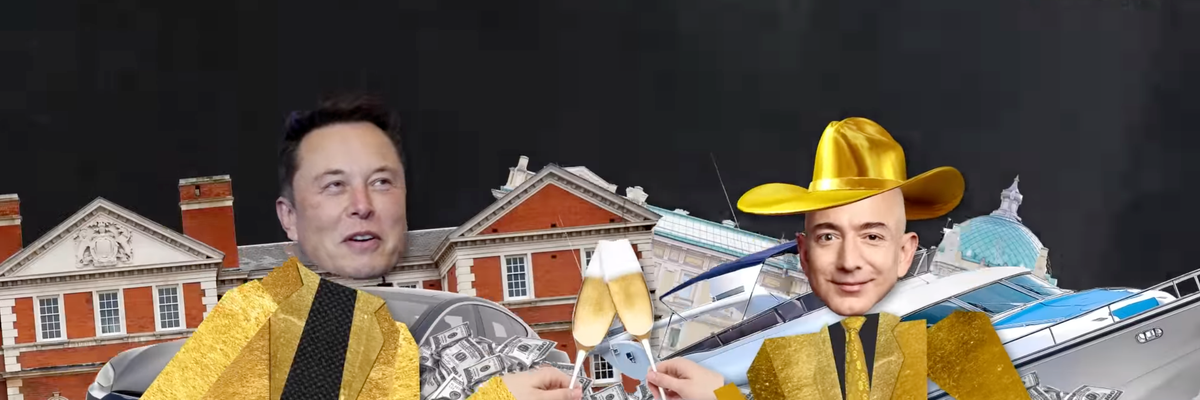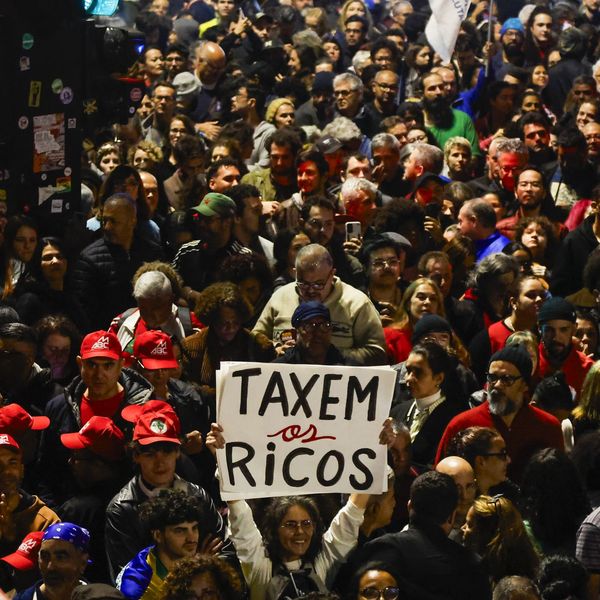
"If you're a regular billionaire, you can afford a private jet," notes Reich. "If you're a centibillionaire, you can afford a brand-new Gulfstream jet every single day for more than ten years."
Mega-Billionaires and the Gushing Upward Redistribution of Wealth
So how much is a $100 billion anyway?
The word "billionaire" didn't even exist until 1844. Fifty years later, we got "multibillionaire." And for the next 127 years, that was enough.
But in 2020, while the working class faced near-record unemployment during the pandemic, the wealthiest Americans faced a different problem. Some of them had gotten so rich, there was no longer a word to describe just how rich they were.
That's why I want to bring you one of the newest additions to the English language: "centibillionaires," people with $100 billion or more.
What's it like being one of history's first centibillionaires? It's hard to even imagine, but let's try it by comparing them to the less fortunate. By which I mean just ... regular ... billionaires.
If you're a regular billionaire, you can afford a private jet. If you're a centibillionaire, you can afford a brand-new Gulfstream jet every single day for more than ten years. (Not sure what you'd do with a new Gulfstream every day -- maybe give one to each of your closest 4,000 friends?)
A regular billionaire would struggle to buy their own professional baseball team. Sad, I know. But a centibillionaire could easily buy every team in the entire major league.
If you're a regular billionaire, you can donate to your alma mater and get your name on a building. If you're a centibillionaire, you could single-handedly give every teacher in America an $8,000 raise for 5 straight years.
Of course, that's not all you could do. $100 billion is enough to wipe out all the medical debt in the United States. Or provide permanent shelter for every homeless person in America. Or buy Covid-19 vaccines for the entire world.
Basically what I'm saying is, $100 billion is a lot of money.
More than two and a half million times what the average American worker makes in a year.
So here's the big question. Are these centibillionaires so rich because they work two and half million times harder than the average American? Are they really 100 times smarter than the typical billionaire?
I don't think so. The reason for the rise of centibillionaires is that for decades, wealth hasn't trickled down, it's gushed up, all the way to the very top.
That's not an accident. As it turns out, the system that the super-rich themselves carefully crafted and lobbied for, benefits... the rich!
And while you may not own more private jets than your average centibillionaire, you probably do pay a higher tax rate. And thanks to legal loopholes and the Trump tax cuts, when the wealthiest Americans die, they get to pass on most of their centibillions to their kids tax-free.
We've got two choices as a country. We can tax the richest Americans fairly, and invest that money in ways that benefit all of us.
Or we can keep doing what we're doing, and watch as centibillionaires get even richer while the rest of us get left behind.
If you think wealth and power are too concentrated in the hands of a privileged few now, just imagine what a few more years of trickle-down nonsense will bring.
Of course, it won't be all bad. At least "trillionaire" is easy to say.
An Urgent Message From Our Co-Founder
Dear Common Dreams reader, The U.S. is on a fast track to authoritarianism like nothing I've ever seen. Meanwhile, corporate news outlets are utterly capitulating to Trump, twisting their coverage to avoid drawing his ire while lining up to stuff cash in his pockets. That's why I believe that Common Dreams is doing the best and most consequential reporting that we've ever done. Our small but mighty team is a progressive reporting powerhouse, covering the news every day that the corporate media never will. Our mission has always been simple: To inform. To inspire. And to ignite change for the common good. Now here's the key piece that I want all our readers to understand: None of this would be possible without your financial support. That's not just some fundraising cliche. It's the absolute and literal truth. We don't accept corporate advertising and never will. We don't have a paywall because we don't think people should be blocked from critical news based on their ability to pay. Everything we do is funded by the donations of readers like you. Will you donate now to help power the nonprofit, independent reporting of Common Dreams? Thank you for being a vital member of our community. Together, we can keep independent journalism alive when it’s needed most. - Craig Brown, Co-founder |
The word "billionaire" didn't even exist until 1844. Fifty years later, we got "multibillionaire." And for the next 127 years, that was enough.
But in 2020, while the working class faced near-record unemployment during the pandemic, the wealthiest Americans faced a different problem. Some of them had gotten so rich, there was no longer a word to describe just how rich they were.
That's why I want to bring you one of the newest additions to the English language: "centibillionaires," people with $100 billion or more.
What's it like being one of history's first centibillionaires? It's hard to even imagine, but let's try it by comparing them to the less fortunate. By which I mean just ... regular ... billionaires.
If you're a regular billionaire, you can afford a private jet. If you're a centibillionaire, you can afford a brand-new Gulfstream jet every single day for more than ten years. (Not sure what you'd do with a new Gulfstream every day -- maybe give one to each of your closest 4,000 friends?)
A regular billionaire would struggle to buy their own professional baseball team. Sad, I know. But a centibillionaire could easily buy every team in the entire major league.
If you're a regular billionaire, you can donate to your alma mater and get your name on a building. If you're a centibillionaire, you could single-handedly give every teacher in America an $8,000 raise for 5 straight years.
Of course, that's not all you could do. $100 billion is enough to wipe out all the medical debt in the United States. Or provide permanent shelter for every homeless person in America. Or buy Covid-19 vaccines for the entire world.
Basically what I'm saying is, $100 billion is a lot of money.
More than two and a half million times what the average American worker makes in a year.
So here's the big question. Are these centibillionaires so rich because they work two and half million times harder than the average American? Are they really 100 times smarter than the typical billionaire?
I don't think so. The reason for the rise of centibillionaires is that for decades, wealth hasn't trickled down, it's gushed up, all the way to the very top.
That's not an accident. As it turns out, the system that the super-rich themselves carefully crafted and lobbied for, benefits... the rich!
And while you may not own more private jets than your average centibillionaire, you probably do pay a higher tax rate. And thanks to legal loopholes and the Trump tax cuts, when the wealthiest Americans die, they get to pass on most of their centibillions to their kids tax-free.
We've got two choices as a country. We can tax the richest Americans fairly, and invest that money in ways that benefit all of us.
Or we can keep doing what we're doing, and watch as centibillionaires get even richer while the rest of us get left behind.
If you think wealth and power are too concentrated in the hands of a privileged few now, just imagine what a few more years of trickle-down nonsense will bring.
Of course, it won't be all bad. At least "trillionaire" is easy to say.
The word "billionaire" didn't even exist until 1844. Fifty years later, we got "multibillionaire." And for the next 127 years, that was enough.
But in 2020, while the working class faced near-record unemployment during the pandemic, the wealthiest Americans faced a different problem. Some of them had gotten so rich, there was no longer a word to describe just how rich they were.
That's why I want to bring you one of the newest additions to the English language: "centibillionaires," people with $100 billion or more.
What's it like being one of history's first centibillionaires? It's hard to even imagine, but let's try it by comparing them to the less fortunate. By which I mean just ... regular ... billionaires.
If you're a regular billionaire, you can afford a private jet. If you're a centibillionaire, you can afford a brand-new Gulfstream jet every single day for more than ten years. (Not sure what you'd do with a new Gulfstream every day -- maybe give one to each of your closest 4,000 friends?)
A regular billionaire would struggle to buy their own professional baseball team. Sad, I know. But a centibillionaire could easily buy every team in the entire major league.
If you're a regular billionaire, you can donate to your alma mater and get your name on a building. If you're a centibillionaire, you could single-handedly give every teacher in America an $8,000 raise for 5 straight years.
Of course, that's not all you could do. $100 billion is enough to wipe out all the medical debt in the United States. Or provide permanent shelter for every homeless person in America. Or buy Covid-19 vaccines for the entire world.
Basically what I'm saying is, $100 billion is a lot of money.
More than two and a half million times what the average American worker makes in a year.
So here's the big question. Are these centibillionaires so rich because they work two and half million times harder than the average American? Are they really 100 times smarter than the typical billionaire?
I don't think so. The reason for the rise of centibillionaires is that for decades, wealth hasn't trickled down, it's gushed up, all the way to the very top.
That's not an accident. As it turns out, the system that the super-rich themselves carefully crafted and lobbied for, benefits... the rich!
And while you may not own more private jets than your average centibillionaire, you probably do pay a higher tax rate. And thanks to legal loopholes and the Trump tax cuts, when the wealthiest Americans die, they get to pass on most of their centibillions to their kids tax-free.
We've got two choices as a country. We can tax the richest Americans fairly, and invest that money in ways that benefit all of us.
Or we can keep doing what we're doing, and watch as centibillionaires get even richer while the rest of us get left behind.
If you think wealth and power are too concentrated in the hands of a privileged few now, just imagine what a few more years of trickle-down nonsense will bring.
Of course, it won't be all bad. At least "trillionaire" is easy to say.

